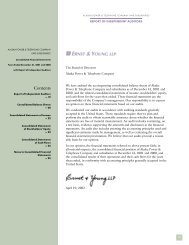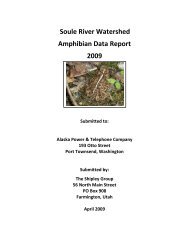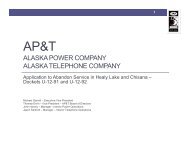Draft Study Plan Vol 1 (PDF) - Alaska Power and Telephone Company
Draft Study Plan Vol 1 (PDF) - Alaska Power and Telephone Company
Draft Study Plan Vol 1 (PDF) - Alaska Power and Telephone Company
Create successful ePaper yourself
Turn your PDF publications into a flip-book with our unique Google optimized e-Paper software.
DRAFT DOCUMENT<br />
Dam<br />
Dam Type: Because there would not be a road to the Connelly Lake dam site,<br />
GLH believes the most economical type of dam would be a rockfill dam, with the rockfill<br />
derived from a quarry near the dam site.<br />
GLH believes that the most suitable dam types would be either a concrete-faced<br />
rockfill dam or a rockfill dam with an upstream geomembrane protected by riprap; both<br />
options will be evaluated. Rockfill volumes would not be significantly different between<br />
the two types, <strong>and</strong> GLH does not expect any significantly differing environmental<br />
impacts. Both types can be developed with acceptable levels of safety for the seismic<br />
environment of the site.<br />
Dam Height: Compared to a low dam, a higher dam would provide more storage<br />
<strong>and</strong> greater generation, but at greater cost. GLH will evaluate the costs <strong>and</strong> benefits of<br />
four dam heights to provide a basis for the final selection, as shown in the following<br />
Table I. The highest dam (75 feet high with the crest at El 2350) is about the maximum<br />
that can be constructed using a rockfill type of dam with appropriate face slopes. GLH<br />
recommends that the highest dam option be the basis for study requests.<br />
Table I: Dam Height Options<br />
Dam height, feet 0 (1) 25 50 75<br />
Dam crest elevation, feet N.A. 2300 2325 2350<br />
Normal maximum water<br />
surface elevation, feet<br />
2278 (2) 2290 2315 2340<br />
Active storage, acre-feet (3) 1,250 2,640 6,380 10,630<br />
(1) Use existing lake only (no dam, i.e. Alternative 1)<br />
(2) Approximate existing lake elevation<br />
(3) Between El 2258 <strong>and</strong> the normal maximum water surface elevation<br />
Transportation: Construction materials, equipment, <strong>and</strong> personnel would need<br />
to be transported to the dam site from the powerhouse area. Initially, this would need to<br />
be accomplished by helicopter; a heavy-lift helicopter would be necessary for large<br />
pieces of equipment on a one-time basis, but personnel, materials, <strong>and</strong> tools would<br />
require only a smaller machine on a daily basis.<br />
GLH will also evaluate the feasibility of using the highline system for<br />
transportation to the dam site. Note that with the proposed rockfill type of dam,<br />
construction materials to be brought up to the dam site would be mostly cement,<br />
reinforcing steel, form plywood, diesel fuel, <strong>and</strong> explosives; rock, s<strong>and</strong>, <strong>and</strong> gravel would<br />
be derived from excavations up at the dam site.<br />
Spillway<br />
For reliability <strong>and</strong> ease of maintenance, GLH would use an ungated spillway with<br />
a concrete control weir. GLH believes that it would be appropriate to size the spillway to<br />
pass the Probable Maximum Flood (PMF) with the water level at or below the dam crest.<br />
<strong>Draft</strong> <strong>Study</strong> <strong>Plan</strong> – June 2012 p. 6 Connelly Lake Hydroelectric Project








